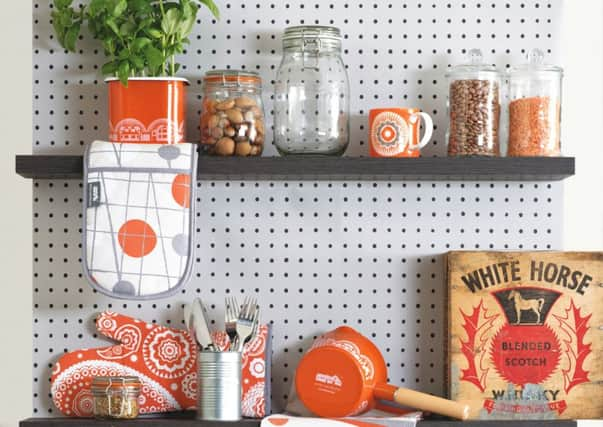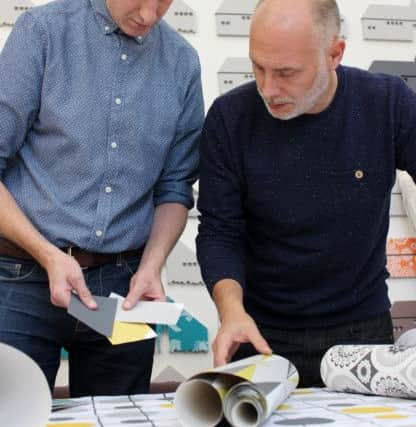Off the shelf: Mary, Mungo and Midge, Whitby and a C60 cassette


Nostalgia plays a big part in the design process for the firm’s founding partners, Pudsey-born Mark Hampshire and Keith Stephenson, originally from Guisborough.
Their childhoods are rooted in the 1960s and 70s and they came of age in the early 80s. Now based in London, their first commercial print on wallpaper was named “Do you live in a town?” – the opening line on the children’s cartoon Mary, Mungo and Midge. It was immediately snapped up by top interiors store Heal’s.
Advertisement
Hide AdAdvertisement
Hide Ad“We both loved Mary, Mungo and Midge because it was so urban. They lived in a block of flats and had adventures, which was different from most children’s programmes in the 1960s,” says Keith.


Their C-60 print featuring music cassettes emanates from their teenage years when compiling mix tapes was a must. The wallpaper was used for interiors at BBC Radio 2 and 6 Music. The contemporary paisleys in their Buddha of Suburbia collection were inspired by east London’s cultural mix and the 1990 book by Hanif Kureishi.
They describe their work as “pattern with a story” with influences ranging from mid-century modern design and vintage toys to literature, telly and childhood memories. Their prints are now applied to everything from wallpapers, fabrics and rugs to ceramics, candles and even radios.
Whitby, featuring Coble boats and choppy seas, came out in 2011 and is their best-selling design. Keith spent most of his childhood holidays in the town, while Mark built his sandcastles in nearby Filey. “We both love Whitby and we did think of buying a holiday home there but in the end it is just too far from London for a weekend retreat, so we bought a beach house in Dungeness instead,” says Mark. That barren stretch of the Kent coast also features in their designs as Hinterland.
Advertisement
Hide AdAdvertisement
Hide AdThe dynamic design duo show no sign of running out of ideas after ten years trading and the business is still growing. They have a legion of fans, John Lewis stocks their products, as do top independent stores and they sell from their own website.


A vital component of their success is their likeability and compatibility. A perceptive former manager recognised it immediately and it was she who introduced them. “Mark came to work as a strategist at the branding agency where I was creative director in 1997. Our manager sat him next to me and said: ‘I know you two will get on like a house on fire’. She was right,” says Keith.”
They have a lot in common. Both are from up north, their dads are both builders, they each railed against Thatcher, danced to the Smiths and studied in Newcastle. Mark studied English at the university, while Keith was at the Poly studying graphics and was a regular on The Tube, which was filmed up there. They even had some of the same friends, although they didn’t realise it back then.
“I went clubbing on Tuesday and he went on Thursdays so we never bumped into each other,” says Keith, whose previous jobs include designing for Red or Dead in the early days of the label.
Advertisement
Hide AdAdvertisement
Hide AdThey remained best friends when their careers went separate ways – Keith became a freelance design consultant and Mark stayed in the corporate world getting increasingly unhappy until a Belle and Sebastian gig pulled the trigger on his old career. They sang Legal Man, which ends with “Get out of the city and into the sunshine. Get out of the office and into the springtime.” “That was it. I said to Keith, ‘I’m handing in my notice and I’m having six months off’.”
That sabbatical was scuppered by a children’s book deal that the pair worked on together. After that they entered a competition to design a wallpaper for an interiors boutique. It was a smash and Mini Moderns was born in 2006.
Keith does the illustrations and they come up with the concepts together. “Mark is very creative and he is also in charge of colour. I don’t do colour because pattern repeats are quite technical and it’s easier to spot mistakes if you work in black and white,” says Keith.
Another key element of Mini Moderns’ longevity is sound business sense. They began with the one wallpaper design and grew gradually, only giving up their freelance work when they were certain the business was sustainable. While they produce their own wallpaper they license their designs to other manufacturers, including, most recently, Ulster Weavers. “Manufacturing is very expensive and specialist. I had a small designer maker business in the 1990s, which had some success making and selling to Harvey Nichols and Galleries Lafayette in Paris but I learned that I couldn’t scale it up and break even,” says Mark.
Advertisement
Hide AdAdvertisement
Hide AdThey are choosy about who they work with and are keen to be as ethical possible. One of their slogans is “Made in the UK by nice people.”
The next step is to export more and, although they were anti-Brexit, a weak pound may benefit their plans to find stockists in America and Australia, where they already have a cult following thanks to their online shop.
There are also new designs to launch, including the much-anticipated Saturday Night, Sunday Morning, which features a series of windows with scenes inspired by kitchen sink dramas, including Up the Junction, Georgy Girl and A Taste of Honey.
“The backdrop is colour but all the window scenes are in black and white because that’s how we watched them when we were teenagers,” says Keith. “On a portable telly in our bedrooms.”
www.minimoderns.com